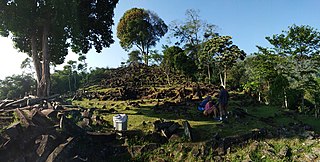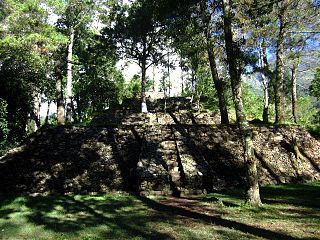
Hinduism in Southeast Asia had a profound impact on the region's cultural development and its history. As the Indic scripts were introduced from India, people of Southeast Asia entered the historical period by producing their earliest inscriptions around the 1st to 5th century CE. Today, Hindus in Southeast Asia are mainly Overseas Indians and Balinese. There are also Javanese and Balamon Cham minority in Cambodia and south central Vietnam who also practice Hinduism.

Hinduism has historically been a major religious and cultural influence in Java, Indonesia. Hinduism was the dominant religion in the region before the arrival of Islam. In recent years, it has also been enjoying something of a resurgence, particularly in the eastern part of the island.

A step pyramid or stepped pyramid is an architectural structure that uses flat platforms, or steps, receding from the ground up, to achieve a completed shape similar to a geometric pyramid. Step pyramids are structures which characterized several cultures throughout history, in several locations throughout the world. These pyramids typically are large and made of several layers of stone. The term refers to pyramids of similar design that emerged separately from one another, as there are no firmly established connections between the different civilizations that built them.

A candi is a Hindu or Buddhist temple in Indonesia, mostly built during the Zaman Hindu-Buddha or "Hindu-Buddhist period" between circa the 4th and 15th centuries.

Sukuh is a 15th-century Javanese-Hindu temple (candi) that is located in Berjo, Ngargoyoso district, Karanganyar Regency, Central Java, Indonesia on the western slope of Mount Lawu . This temple has a height of 87 meters. Sukuh temple has a distinctive thematic relief from other candi where life before birth and sexual education are its main themes. Its main monument is a simple pyramid structure with reliefs and statues in front of it, including three tortoises with flattened shells and a male figure grasping his penis. A giant 1.82 m (6 ft) high of Shishna with four testes, representing penile incisions, was one of the statues that has been relocated to the National Museum of Indonesia.

Tarumanagara or Taruma Kingdom or just Taruma was an early Sundanese Indianised kingdom, located in western Java, whose 5th-century ruler, Purnawarman, produced the earliest known inscriptions in Java, which are estimated to date from around 450 CE.

Muara Takus is a Buddhist temple complex, thought to belong to the Srivijaya empire. It is situated in Kampar Regency in Riau province, Sumatra, Indonesia. Its surviving temples and other archaeological remains are thought to date to the 11th and 12th century AD. It is one of the largest and best-preserved ancient temple complexes in Sumatra.

The Ceto is a fifteenth-century Javanese-Hindu temple that is located on the western slope of Mount Lawu on the border between Central and East Java provinces.

Batujaya is an archeological site located in the village of Batujaya, Karawang in West Java, Indonesia. Archaeologists suggest that the Batujaya temples might be the oldest surviving temple structures in Java and estimated that it was built during the time of the Tarumanegara kingdom circa 5th to 6th century CE.

Prambanan Temple Compounds is the World Heritage designation of a group of Hindu temple compounds that lie on the border between Yogyakarta and Central Java, Indonesia. It comprises Prambanan, Lumbung, Bubrah and Sewu temple compounds, all are located within Prambanan Archaeological Park.

Borobudur Temple Compounds is the World Heritage designation of the area of three Buddhist temples in Central Java, Indonesia. It comprises Borobudur, Mendut, and Pawon. The temples were built during the Shailendra dynasty around the 8th and 9th centuries CE and fall on a straight line.

Ijo temple is a Hindu candi (temple) located 4 kilometers from Ratu Boko or around 18 kilometers east from Yogyakarta, Indonesia. The temple was built between 10th to 11th century CE during the Mataram Kingdom period.

Pura ParahyanganAgung Jagatkarta often referred to simply as Pura Parahyangan is a Hindu temple of Nusantara located in Ciapus village, Tamansari subdistrict, Bogor Regency, West Java, Indonesia.

The archaeology of Indonesia is the study of the archaeology of the archipelagic realm that today forms the nation of Indonesia, stretching from prehistory through almost two millennia of documented history. The ancient Indonesian archipelago was a geographical maritime bridge between the political and cultural centers of Ancient India and Imperial China, and is notable as a part of ancient Maritime Silk Road.

Barong temple is a 9th-century Hindu candi (temple) located approximately 800 meters east-southeast from Ratu Boko compound. The temple is located on a hill in Candisari hamlet, Bokoharjo village, Prambanan subdistrict, Sleman Regency, Yogyakarta, Indonesia. The temple is named barong according to its kala's head carving on top of the niches of its temples that resembles Barong.

Sumberawan is a Buddhist stupa located in Toyomarto village, Sumberawan subdistrict, Malang Regency, East Java, Indonesia. The stupa is located in the highlands, on the southern slope of Mount Arjuno, surrounded by numerous Springs.

Karyamukti is a village in district of Campaka in Cianjur Regency, West Java, Indonesia. It is the location of Gunung Padang Megalithic Site, which lies on a hill made of mouth of an extinct volcano.

Candi Kethek is a terraced megalithic pyramid-shaped 15th-16th century Hindu temple on the northwest slope of Mount Lawu in Anggrasmanis village of Gumeng subdistrict in Jenawi district of Karanganyar Regency in Central Java of Indonesia. The temple has seven terraces facing west, each terrace is connected by stone steps. There is an alternative path to the top terrace on the south side. Kethek Temple is located northeast of the fifteenth-century Javanese-Hindu Ceto Temple. To reach Candi Kethek, visitors must take a 300 m footpath from Ceto Temple in the direction of the path leading to Puri Taman Saraswati.
Lebak Cibedug temple, is a terraced pyramid shaped sacred megalithic site on the bank of Cibedug river near Citorek village in Banten Province at the west end of the island of Java, Indonesia. There are other megalithic menhirs and dolmens on this site.



















